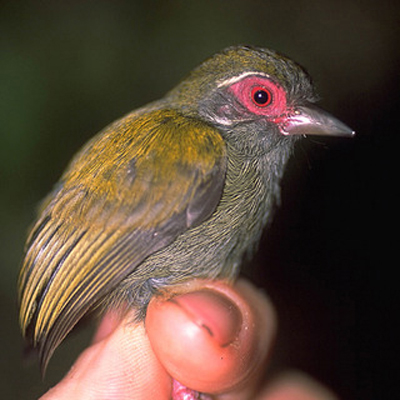THE WORLD BIRDS - An Online Bird Book
The woodpeckers family members are found almost worldwide. Most species live in forests or woodland habitats, although a few species are known to live in treeless areas such as rocky hillsides and deserts. They range in size from 8-50 cm. Many species exhibit patches of red and yellow on their heads and bellies, and these bright areas are important in signalling. Although the sexes of Picidae species tend to look alike, many have more prominent red or yellow head markings in males than in females.
Members of the family Picidae have strong bills for drilling and drumming on trees and long sticky tongues for extracting food. Species that use their bills in soil or for probing as opposed to regular hammering tend to have longer and more decurved bills. To prevent brain damage from the rapid and repeated decelerations, woodpeckers have evolved a number of adaptations to protect the brain. These include small brain size and the short duration of contact. The millisecond before contact with wood a thickened membrane closes, protecting the eye from flying debris. The nostrils are also protected, they are often slit-like and have special feathers to cover them. In addition to the strong claws and feet woodpeckers have short strong legs, this is typical of birds that regularly forage on trunks. The tails of most woodpeckers are stiffened, and when the bird perches on vertical surfaces, the tail and feet work together to support it. Picidae species can either be sedentary or migratory.
There are 7 articles pertaining to the woodpecker family Picidae: African, Eurasian, North America, South America, Small, Large, Terrestrial.
Piciformes
The order Piciformes is made up of the woodpecker family Picidae plus 8 other families. Picidae make up about half of the species. In general, the Piciformes are insectivorous, but some exceptions eat mostly fruit. Nearly all Piciformes have parrot-like feet—two toes forward and two back, an arrangement that has obvious advantages for birds that spend much of their time on tree trunks. And most Piciformes do not have down feathers at any age, only true feathers. All nest in cavites.
Family Picidae: Woodpeckers and Allies
The woodpeckers family members are found almost worldwide. Most species live in forests or woodland habitats, although a few species are known to live in treeless areas such as rocky hillsides and deserts. They range in size from 8-50 cm. Many species exhibit patches of red and yellow on their heads and bellies, and these bright areas are important in signalling. Although the sexes of Picidae species tend to look alike, many have more prominent red or yellow head markings in males than in females.
Members of the family Picidae have strong bills for drilling and drumming on trees and long sticky tongues for extracting food. Species that use their bills in soil or for probing as opposed to regular hammering tend to have longer and more decurved bills. To prevent brain damage from the rapid and repeated decelerations, woodpeckers have evolved a number of adaptations to protect the brain. These include small brain size and the short duration of contact. The millisecond before contact with wood a thickened membrane closes, protecting the eye from flying debris. The nostrils are also protected, they are often slit-like and have special feathers to cover them. In addition to the strong claws and feet woodpeckers have short strong legs, this is typical of birds that regularly forage on trunks. The tails of most woodpeckers are stiffened, and when the bird perches on vertical surfaces, the tail and feet work together to support it. Picidae species can either be sedentary or migratory.
There are 7 articles pertaining to the woodpecker family Picidae: African, Eurasian, North America, South America, Small, Large, Terrestrial.
The picutlets are mainly Central and South American woodpeckers. They are among the smallest of the woodpecker family with short tails and short bills.
The genus Picumnus has 25 species, all of which are found in Central and South America. They are 8 to 11 cm long and most weigh between 8 and 12 grams. Compare that to the pileated woodpecker which is 40 to 49 cm long and weighs 225 to 400 grams! Their upperparts are dark green, brownish, or greyish. Their crown is black and usually has white dots. The typical male has red or yellow dots / stripes on the forecrown. Their bills are a combination of black and grey with the upper-mandible being more black and the lower-mandible more grey - especially at the base. The tongue is long so it can be inserted in excated holes to capture the prey. They eat small insects, favoring ants, termites, beetles and their larvae. Foraging is done in trees, a combination of gleaning and also typical woodpecker hammering with their wedge-shapaed bills. The nest is excavated in a dead tree or dead limb.
The enus Sasia has two Southeast Asian species and Verreauxia has the African piculet. The Antillean piculet (Nesoctites micromegas) is approximately 3 times heavier than other piculets and is only distantly related to them.
Genus Nesoctites - 1 genus
Piculet,_Antillean Nesoctites micromegas
Description: The Antillean piculet has olive green upperparts and off-white underparts with streaks and spots. The male has a yellow crown with a red spot in the center. The female lacks the red spot. The Antillean piculet is 11 to 16 cm long and weighs about 30 grams which is approximately 3 times heavier than other piculets. In fact, this species is only distantly related to the other piculets.
Range: Caribbean island of Hispaniola.
Habitat: Broadleaf forests, scrubland, thorn-forest, mangroves. Also orchards and plantations.
Diet: Mainly ants, beetles, and their larvae. Also other insects.
Conservation status: Least Concern.
Image by: 1, 2) Ron_KnightRange: Caribbean island of Hispaniola.
Habitat: Broadleaf forests, scrubland, thorn-forest, mangroves. Also orchards and plantations.
Diet: Mainly ants, beetles, and their larvae. Also other insects.
Conservation status: Least Concern.
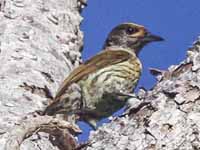
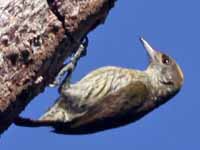
Genus Picumnus (Asia)
Piculet,_Speckled Picumnus innominatus
Description: The speckled piculet has olive-green upperparts. It has a thick black eye-line which is bordered above and below with a white stripe. It also has a black malar stripe. The underparts are creamy-white with black spots. The male has orange and brown on his fore-crown while the female has a dark brown crown. The speckled piculet is about 9 cm long and weighs 9 to 13 grams. The nest is excavated in a dead tree or dead limb. Both parents excavate the nest-cavity, incubate, and both feed the chicks.
Range: Indian subcontinent, southeast Asia, Indonesia, Malaysia.
Habitat: Various types of forests; also bamboo.
Diet: Mainly ants and termites. Forages in trees and undergrowth, often hanging upside-down.
Conservation status: Least Concern.
Image by: 1) Naturelly 2) Francesco Veronesi - Thailand 3) Imran_Shah - PakistanRange: Indian subcontinent, southeast Asia, Indonesia, Malaysia.
Habitat: Various types of forests; also bamboo.
Diet: Mainly ants and termites. Forages in trees and undergrowth, often hanging upside-down.
Conservation status: Least Concern.
1) Female 2) Male
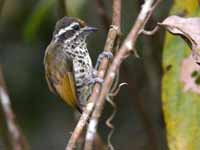
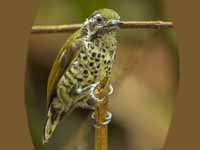
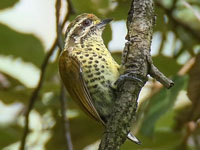
Genus Picumnus
This genus has the vast majority of the piculets. They are found in Central and South America.
Piculet,_Arrowhead Picumnus minutissimus
Description: The arrowhead piculet has olive-brown upperparts which are browner over wings, and whitsih underparts marked with brownish-black scales. Upperpart feathers have blackish wedge-shaped centers, whence its name. The male has a predominantly red crown while the female has a black crown with white spots. The arrowhead piculet is 9 to 10 cm long and weighs 10 to 15 grams. The male mainly excavates the nest-cavity, but both parrents incubate,and both feed the chicks.
Range: Northeastern South America in French Guiana, Guyana, Suriname.
Habitat: Secondary forests, plantations, mangroves, and more.
Diet: Small insects. It forages on small branches.
Conservation status: Least Concern.
Image by: 1) Mike_Allen - Suriname 2) Henk Nijssen in GuyanaRange: Northeastern South America in French Guiana, Guyana, Suriname.
Habitat: Secondary forests, plantations, mangroves, and more.
Diet: Small insects. It forages on small branches.
Conservation status: Least Concern.
1) Female 2) Male
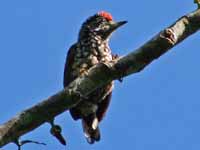
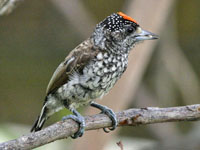
Piculet,_Bar-breasted Picumnus aurifrons
Description: The bar-breasted piculet has yellowish-green plumage. There is horizontal barring on the breast and vertical stripes on the belly. It has a black forehead and crown which are mostly cover with white dots. The male has yellow dots on his forehead. It is about 8 cm long and 9 grams.
Range: Bolivia, Brazil, Colombia, and Peru.
Habitat: Forests edges and clearings; also second growth forests.
Diet: Insects and larvae; forages in trees, usually high up.
Conservation status: Least Concern.
Image by: 1) Anselmo_d’Affonseca 2) Nick_Athanas - BrazilRange: Bolivia, Brazil, Colombia, and Peru.
Habitat: Forests edges and clearings; also second growth forests.
Diet: Insects and larvae; forages in trees, usually high up.
Conservation status: Least Concern.
1, 2) Male
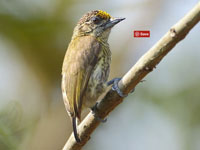
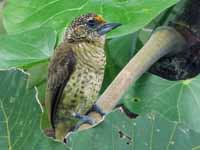
Piculet,_Chestnut Picumnus cinnamomeus
Description: The chestnut piculet has mainly chestnut-brown plumage and a black crown flecked with gold (males), or a black crown flecked whitish (females). It has a whitish forehead and yellow orbital skin. The chestnut-brown belly is paler than the upperparts. The chestnut piculet is 9 to 10 cm long.
Range: Northern Colombia, northwestern Venezuela.
Habitat: Varies from rainforest to relatively open areas with a few trees.
Diet: Small insects. Forages on trees and vines.
Conservation status: Least Concern.
Image by: 1) Andrew_Spencer 2) Nick_Athanas - ColumbiaRange: Northern Colombia, northwestern Venezuela.
Habitat: Varies from rainforest to relatively open areas with a few trees.
Diet: Small insects. Forages on trees and vines.
Conservation status: Least Concern.
1) Female 2) Male

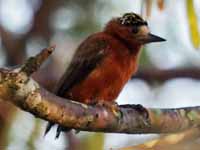
Piculet,_Ecuadorian Picumnus sclateri
Description: The Ecuadorian piculet has greyish-brownish upperparts, a black cap spotted with white (male has some yellow spots), and whitish underparts with brown barring. The Ecuadorian piculet is 9 to 10 cm long and weighs about 10 grams.
Range: Ecuador, Peru.
Habitat: Dry forests and scrub.
Diet: Small insects.
Conservation status: Least Concern.
Image by: 1, 2) Nick_Athanas - Ecuador, Peru 3) Francesco_Veronesi - Ecuador Range: Ecuador, Peru.
Habitat: Dry forests and scrub.
Diet: Small insects.
Conservation status: Least Concern.
1, 2) Female 3) Male
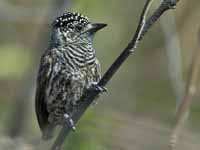
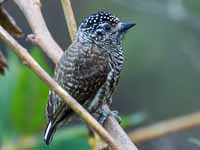
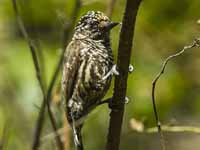
Piculet,_Fine-barred Picumnus subtilis
Description: The fine-barred piculet has olive upperparts and a black crown (male's has some red) with white spots. The underparts are pale grey with darker fine barring. It is similar to the plane-breasted piculet, but that does not have fine white spots on the head.
Range: Eastern Peru, western Brazil.
Habitat: Subtropical or tropical moist lowland forests and heavily degraded former forest.
Diet: Small insects.
Conservation status: Least Concern.
Image by: 1) Silvia Faustino Linhares 2) Hector_Bottai - BrazilRange: Eastern Peru, western Brazil.
Habitat: Subtropical or tropical moist lowland forests and heavily degraded former forest.
Diet: Small insects.
Conservation status: Least Concern.
1, 2) Male
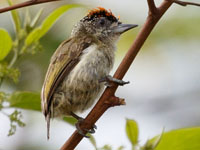
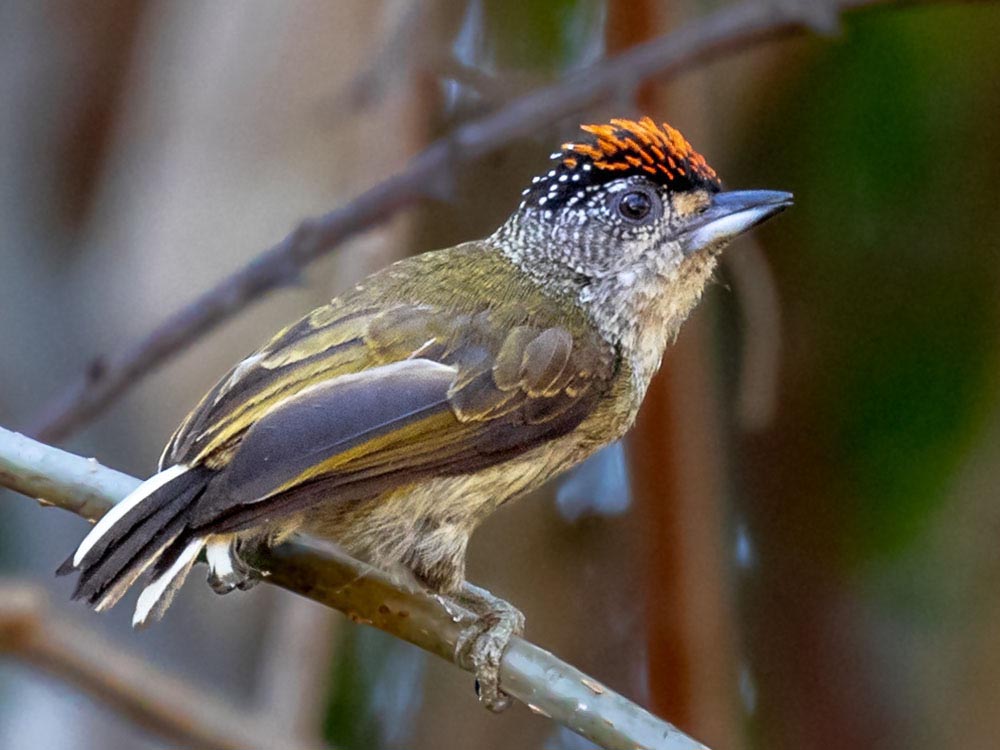
Piculet,_Golden-spangled Picumnus exilis
Description: The golden-spangled piculet has faintly spotted olive-green upperparts with white dots on the wing-coverts. It has a black cap with many white dots (male has golden spots at the forehead) and a small white patch above the base of bill. The underparts are whitish with heavy dark barring. The golden-spangled piculet is 8 to 10 cm long and about 9 grams. The similar Lafresnaye's piculet does not have a small white patch above base of bill, The golden-spangled piculet has darker barring on underparts than the similar Orinoco piculet.
Range: Brazil, Colombia, French Guiana, Guyana, Suriname, and Venezuela.
Habitat: Forest edges and opennings, savannas with trees.
Diet: Ants and probably other small insects.
Conservation status: Least Concern.
Image by: 1) Guilherme Jófili 2, 4) Nick_Athanas 3) Claudio_D_Timm - BrazilRange: Brazil, Colombia, French Guiana, Guyana, Suriname, and Venezuela.
Habitat: Forest edges and opennings, savannas with trees.
Diet: Ants and probably other small insects.
Conservation status: Least Concern.
1, 2) Female 4) Male
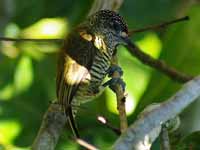

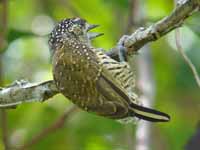
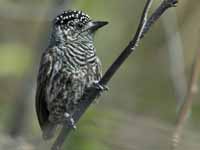
Piculet,_Greyish Picumnus granadensis
Description: The greyish piculet has greenish-brown upperparts and ear coverts. It has a black cap with white freckles (male forehead has yellow freckles). The underparts are light grey (most subspecies have faint streaks). It has a black bill and grey legs. The greyish piculet is 9 to 10 cm long and weighs 12 to 13 grams. The similar white-bellied piculet has speckled flanks, while the greyish piculet does not, Theri ranges not overlap.
Range: Columbia.
Habitat: Tropical and subtropical forests, coffee plantations, and heavily degraded former forest.
Diet: Small insects.
Conservation status: Least Concern.
Image by: 1) Dave Curtis 2) Francesco_Veronesi 3) Ron Knight 4) Arley_VargasRange: Columbia.
Habitat: Tropical and subtropical forests, coffee plantations, and heavily degraded former forest.
Diet: Small insects.
Conservation status: Least Concern.
1, 2) Female 3, 4) Male
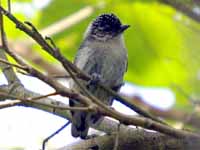
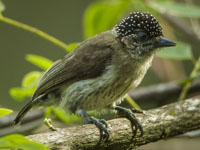

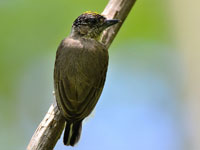
Piculet, Lafresnaye's Picumnus lafresnayi
Description: The Lafresnaye's piculet has dark green upperparts with yellowish barring, a black cap with mainly white dots (male has yellowis-red forehead). The throat and chin are buff with some dark barring and the underparts are black-barred yellowish. It has a black bill with a grey base and grey legs. The greyish piculet is 9 to 10 cm long and weighs about 10 grams. The similar golden-spangled piculet has yellow spangles on its back instead of barring and it also has a white patch above the base of bill. The similar Orinoco piculet has thinner barring onthe underparts than Lafresnaye's piculet.
Range: Brazil, Columbia, Ecuador, Peru.
Habitat: Second grown forests, forest edges and clearings.
Diet: Temites and probably other small insects plus larvae.
Conservation status: Least Concern.
Image by: 1) Anselmo_d’Affonseca 2, 3) Tony_Castro 4) Nick_AthanasRange: Brazil, Columbia, Ecuador, Peru.
Habitat: Second grown forests, forest edges and clearings.
Diet: Temites and probably other small insects plus larvae.
Conservation status: Least Concern.
1,2) Female 3, 4) Male
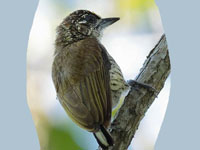
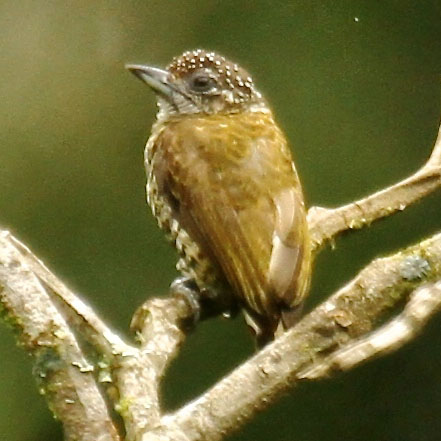
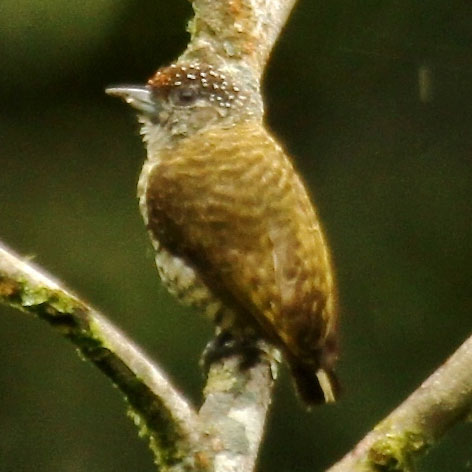
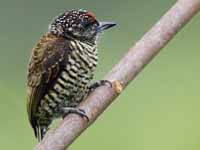
Piculet, Mottled Picumnus nebulosus
Description: The mottled piculet has brown upperparts, a whitish throat with black bars, yellowish-buff underparts with broad black streaks, and a black cap with mainly white dots (male has red streaks on forehead). It has grey legs and a dark bill with a lighter grey to the base of the lower mandible. The mottled piculet is 10 to 11 cm long an weighs about 11 grams.
Range: Argentina, Brazil, Uruguay.
Habitat: Forest edges, secondary forests, bamboo thickets.
Diet: Probably insects and their larvae.
Conservation status: It is listed as Near Threatened because of its limited range and not being observed often.
Image by: 1) Gmmv1980 - Uruguay 2, 3) Cláudio Timm - Brazil Hector_Bottai - BrazilRange: Argentina, Brazil, Uruguay.
Habitat: Forest edges, secondary forests, bamboo thickets.
Diet: Probably insects and their larvae.
Conservation status: It is listed as Near Threatened because of its limited range and not being observed often.
1, 2) Female 3, 4) Male
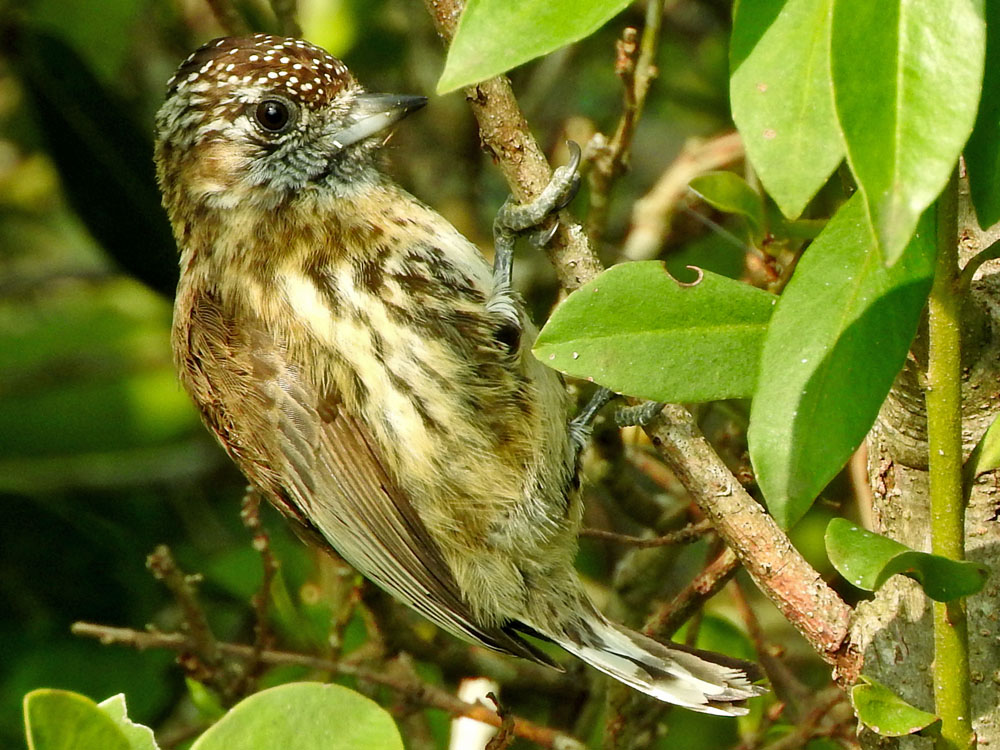
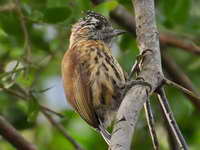
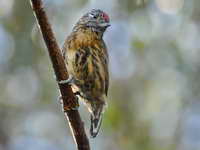
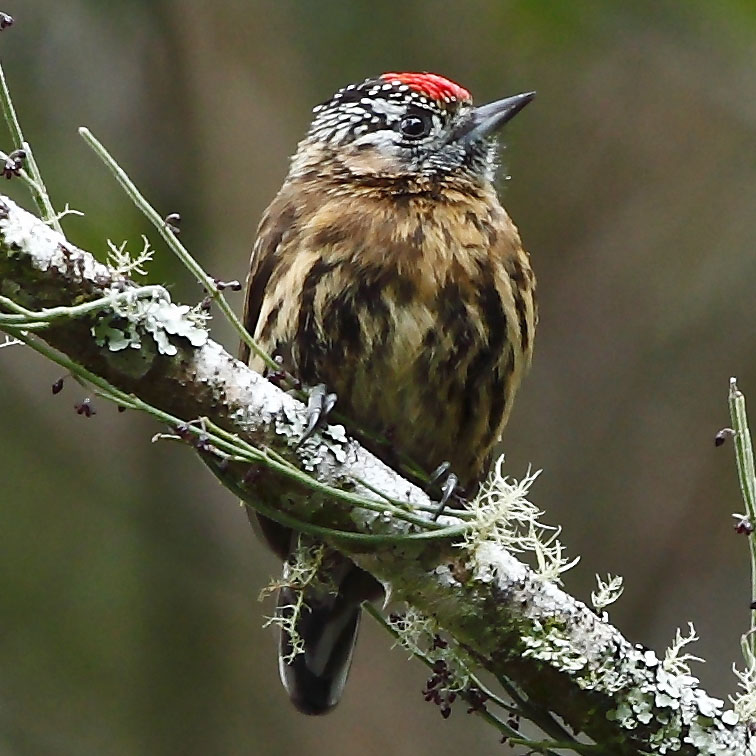
Piculet,_Ocellated Picumnus dorbignyanus
Description: The ocellated piculet has grey or greyish-brown upperparts, white or buffy underparts with scales or sparse black spots, a black or greyish-brown crown (red fore-crown for male). The ocellated piculet is 9 to 10 cm long.
Range: Argentina, Bolivia, Peru.
Habitat: Foothills on the eastern side of the Andes in moist forests where it frequents bushy undergrowth with vines,
Diet: Small insects andother invertebrates.
Conservation status: Least Concern.
Image by: 1) Joseph_Smit Range: Argentina, Bolivia, Peru.
Habitat: Foothills on the eastern side of the Andes in moist forests where it frequents bushy undergrowth with vines,
Diet: Small insects andother invertebrates.
Conservation status: Least Concern.
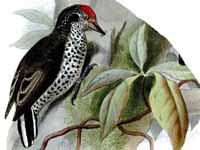
Piculet,_Ochraceous Picumnus limae
Description: The ochraceous piculet has brown upperparts, pale tawny underparts with faint streaks over the breast, abd a black crown which is spotted with white. The male has red on his fore-crown. It has a greyish bill with a black tip and the upper-mandible has more black at its base. The legs are bluish-grey. The ochraceous piculet is about 10 cm long. The similar tawny piculet has darker underparts. Also its range is more south and east than ochraceous's range.
Range: Eastern Brazil.
Habitat: Forest with some deciduous trees, forest edges, scrub with some trees, bamboo thickets.
Diet: Insects and larvae.
Conservation status: Least Concern.
Image by: 1) Joao_Quental, 2) Celuta_Machado 3) Hector Bottai Range: Eastern Brazil.
Habitat: Forest with some deciduous trees, forest edges, scrub with some trees, bamboo thickets.
Diet: Insects and larvae.
Conservation status: Least Concern.
1) Female 2, 3) Male
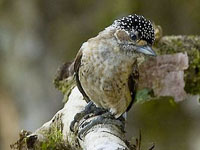
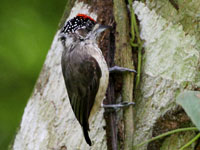
Piculet,_Ochre-collared Picumnus temminckii
Description: The ochre-collared piculet has brown upperparts plus an ochre face and hind-neck. It has black-barred white underparts and a black cap with mainly white dots (male has red fore-crown). The nape and the sides of the neck form a cinnamon collar. Its bill is mainly black, but the lower mandible has a grey base. The legs are greyish. The ochre-collared piculet is 9 to 10 cm long and weighs about 11 grams.
Range: Northeast Argentina, southeast Brazil, eastern Paraguay.
Habitat: Lowland rainforest with bamboos, vines and tangled growth; also secondary growth, thickets,.
Diet: Ants, beetle larvae, other small invertebrates.
Conservation status: Least Concern.
Image by: 1, 2, 3)
Dario Sanches - Brazil 4) Ben Tavener - Brazil Range: Northeast Argentina, southeast Brazil, eastern Paraguay.
Habitat: Lowland rainforest with bamboos, vines and tangled growth; also secondary growth, thickets,.
Diet: Ants, beetle larvae, other small invertebrates.
Conservation status: Least Concern.
1. 2) Female 3, 4) Male
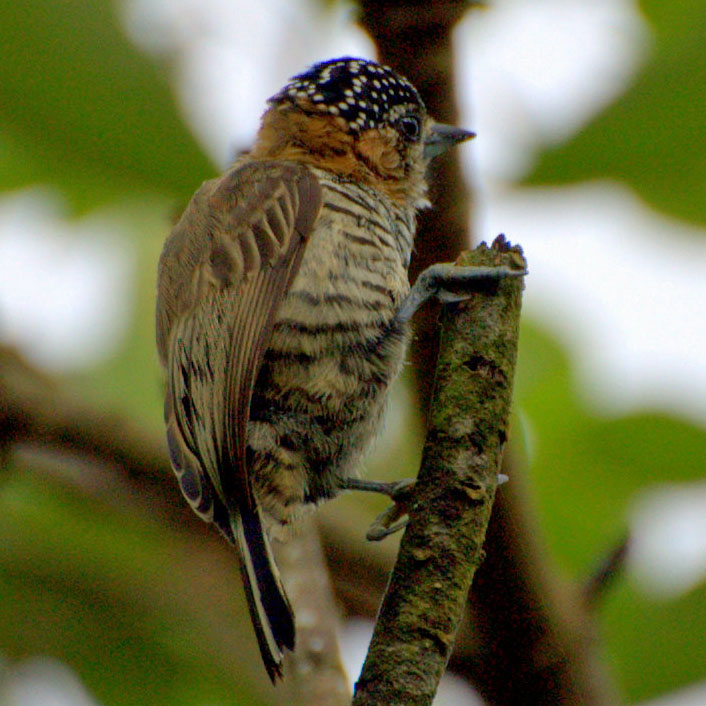


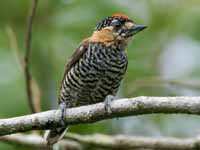
Piculet, Olivaceous Picumnus olivaceus
Description: The olivaceous piculet has olive-brown upperparts. It has a black cap with many white dots (male has red-streaked forehead) and with darker brown streaks. The nape is brownish and the underparts are cream, lightly streaked with olive-brown. It is 8.5 to 10 cm long. The bill is black with a little grey at the base of the lower mandible and the legs are grey.
Range: Central America, Columbia, Ecuador, Venezuela.
Habitat: Subtropical or tropical forests; also degraded forests.
Diet: Ants, termites, beetles and insect larvae.
Conservation status: Least Concern.
Image by: 1) Neil_Martinez - Columbia 2) Jei_Pov - Columbia 3) Sergey_Pisarevskiy - ColumbiaRange: Central America, Columbia, Ecuador, Venezuela.
Habitat: Subtropical or tropical forests; also degraded forests.
Diet: Ants, termites, beetles and insect larvae.
Conservation status: Least Concern.
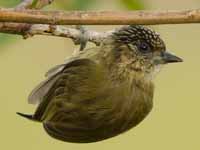
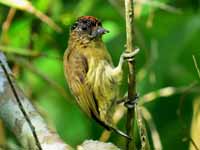
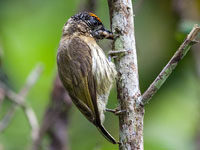
Piculet, Orinoco Picumnus pumilus
Description: The Orinico piculet has olive-brown upperparts which are sometimes barred with tawny brown. It has a black cap with mainly white dots (male has yellow dots on forehead). The underparts are black-barred yellowish and the bill is black with a grey base. It is 9 cm long. The similar Lafresnaye's piculet has thicker barring on the underparts.
Range: Brazil, Colombia, and Venezuela.
Habitat: Subtropical or tropical moist lowland forests.
Diet: Termites, ants, insect larvae, and other small invertebrates.
Conservation status: Least Concern.
Image by: 1, 2) Diego Calderon 3) Nick_Athanas - ColumbiaRange: Brazil, Colombia, and Venezuela.
Habitat: Subtropical or tropical moist lowland forests.
Diet: Termites, ants, insect larvae, and other small invertebrates.
Conservation status: Least Concern.
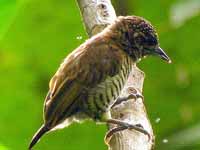

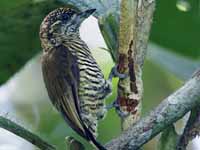
Piculet,_Plain-breasted Picumnus castelnau
Description: The plain-breasted piculet has greyish-olive upperparts, a black crown, and whitish underparts. The male has some red on the crown. The plain-breasted piculet is 9 to 10 cm long.
Range: Eastern side of the Andes in Brazil, Colombia, Ecuador, Peru.
Habitat: Secondary forests, wooded pastures, lowland forests.
Diet: Insects. Details unknown.
Conservation status: Least Concern.
Image by: 1, 2) Felix_Uribe - Columbia 3) Susana Cubas PoclinRange: Eastern side of the Andes in Brazil, Colombia, Ecuador, Peru.
Habitat: Secondary forests, wooded pastures, lowland forests.
Diet: Insects. Details unknown.
Conservation status: Least Concern.
1 - 3) Female
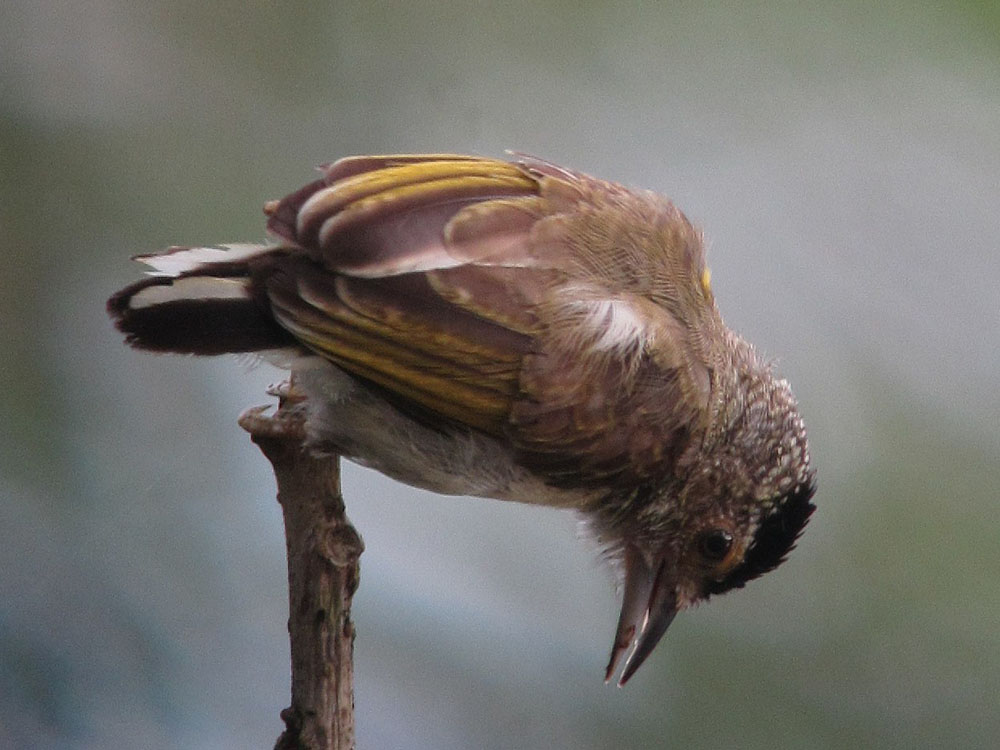
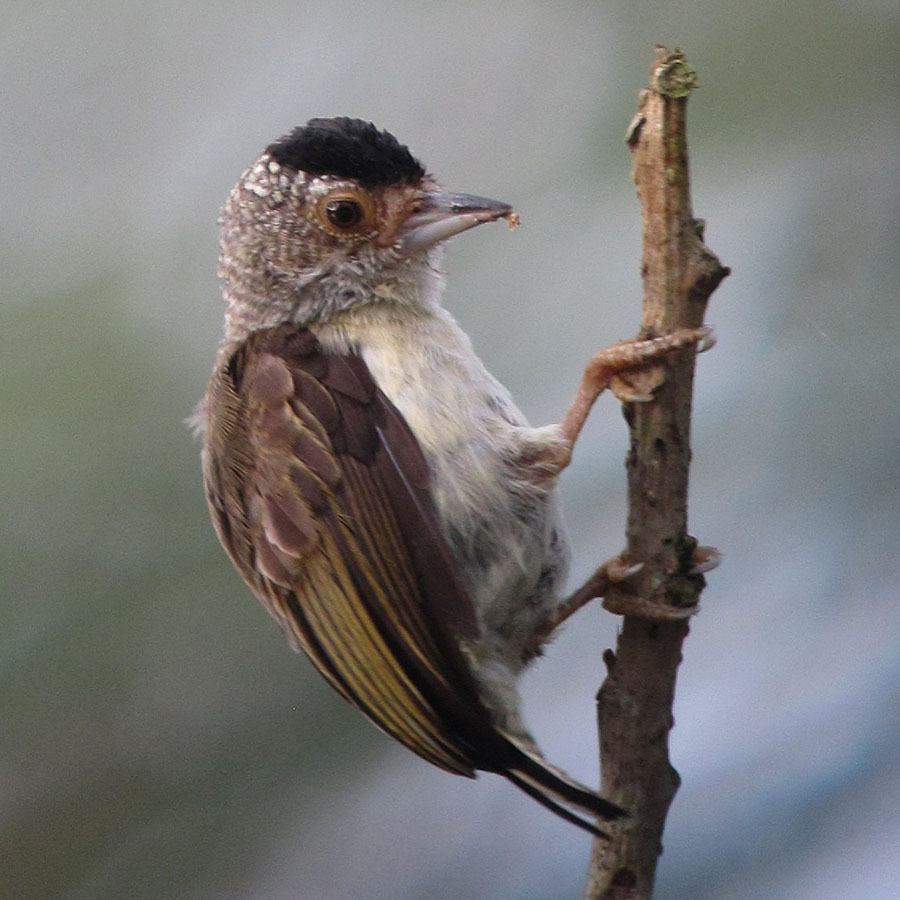
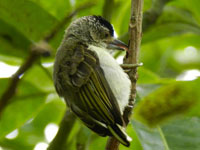
Piculet,_Rufous-breasted Picumnus rufiventris
Description: The rufous-breasted piculet has green upperparts with some rufous on the mantle. It has a black crown with white spots (some red for the male). The underparts are rufous-chestnut. The rufous-breasted piculet is 11 cm long which is large for a piculet, but small for a woodpecker.
Range: Bolivia, Colombia, Ecuador, Peru. Also western Brazil.
Habitat: Subtropical or tropical moist lowland forest; also heavily degraded former forest.
Diet: Probably insects.
Conservation status: Least Concern.
Image by: 1) Hector_Borttai - female in BrazilRange: Bolivia, Colombia, Ecuador, Peru. Also western Brazil.
Habitat: Subtropical or tropical moist lowland forest; also heavily degraded former forest.
Diet: Probably insects.
Conservation status: Least Concern.
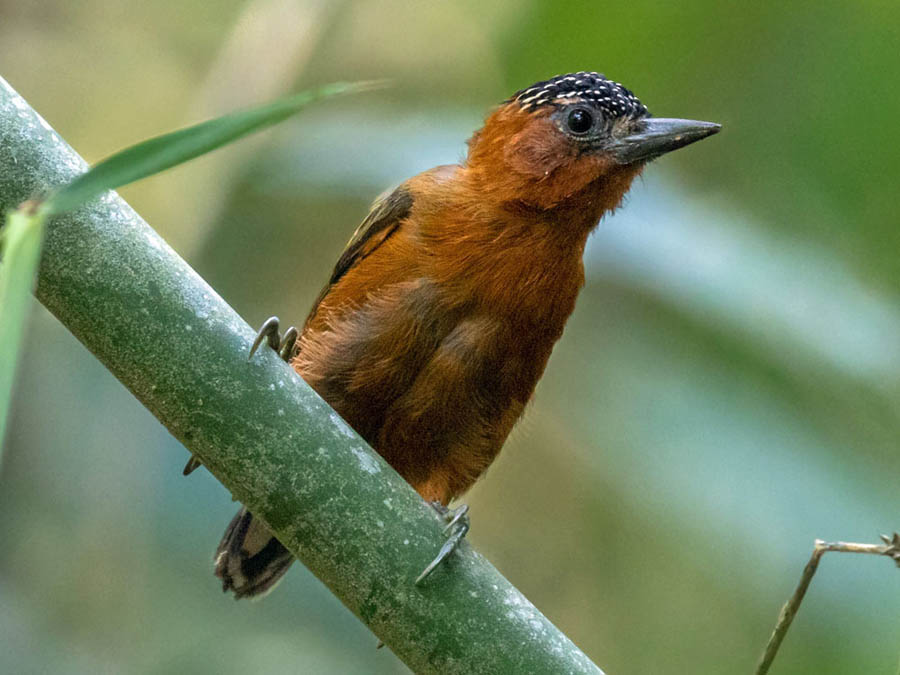
Piculet,_Rusty-necked Picumnus fuscus
Description: The rusty-necked piculet has mainly buffy-cinnamon upperparts. It has a black crown (male has reddish-orange streaking), buff lores, brownish cheeks, and pale buff underparts. The upper-mandible is black and the lower is mainly grey. It has grey legs, The rusty-necked piculet is 10 cm long.
Range: Along Bolivia / Brazil border.
Habitat: Subtropical or tropical swamps/flooded forest.
Diet: Probably small insects.
Conservation status: Least Concern.
Image by: 1) Adrian_Eisen-Rupp Range: Along Bolivia / Brazil border.
Habitat: Subtropical or tropical swamps/flooded forest.
Diet: Probably small insects.
Conservation status: Least Concern.
|1) Male
Piculet,_Scaled Picumnus squamulatus
Description: The scaled piculet has brownish-olive upperparts with a darker scale-like pattern. It gas a black cap with mainly white dots (male has red streaks on forehead). The underparts are white, also with a blackish scale-like pattern. The bill is blackish on the top and more grey on the bottom, It has grey legs. The scaled piculet is 8 to 9 cm long.
Range: Columbia, Venezuela.
Habitat: Woodlands with opennings and clearings, more open countryside with some trees. It likes dense undergrowth and vines.
Diet: Small insects.
Conservation status: Least Concern.
Image by: 1, 2) Barloventomagico - Venezuela 3) Fernando_Flores 4) Andres_CuervoRange: Columbia, Venezuela.
Habitat: Woodlands with opennings and clearings, more open countryside with some trees. It likes dense undergrowth and vines.
Diet: Small insects.
Conservation status: Least Concern.
1 - 3) Famle 4) Male
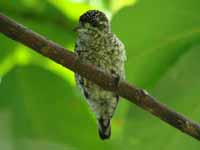

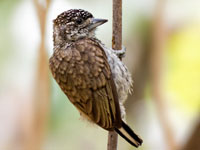
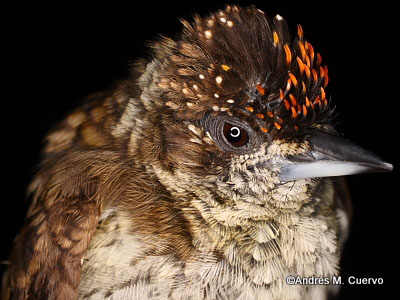
Piculet,_Speckle-chested Picumnus steindachneri
Description: The speckle-chested piculet has grey or greyish-brown upperparts, a black breast speckled with white, and a white belly barred with black. The male has a mainly black crown with red fore-crown while the female has a black crown. The speckle-chested piculet is 8.5 to 10 cm long.
Range: Andes of northern Peru.
Habitat: Moist forests with vines, bamboo thickets; also secondary growth forests, and thickets in cultivated areas.
Diet: Small insects.
Conservation status: It is listed as Vulnerable because of its small range and deforestation.
Image by: 1) Joseph_Smit 2) Nick_Athanas 3) Patty_McGannRange: Andes of northern Peru.
Habitat: Moist forests with vines, bamboo thickets; also secondary growth forests, and thickets in cultivated areas.
Diet: Small insects.
Conservation status: It is listed as Vulnerable because of its small range and deforestation.
1) Pair 2) Female 3) Male

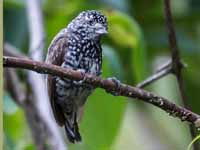
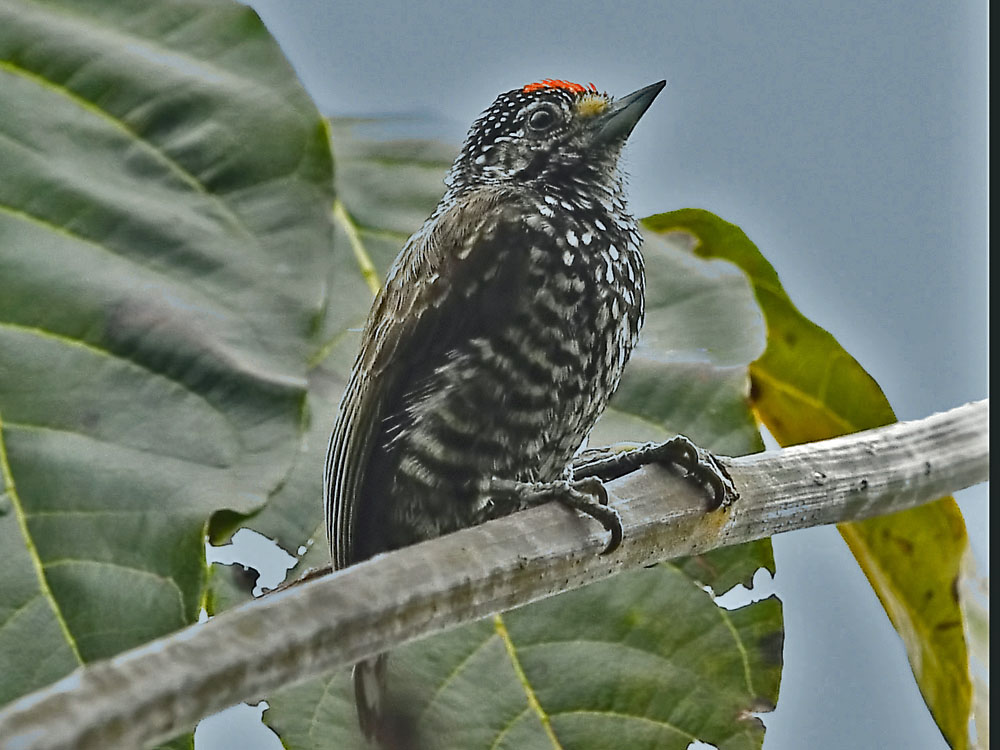
Piculet,_Spotted Picumnus pygmaeus
Description: The spotted piculet has greyish-brown upperparts with white spots, especially on the mantle. The head is black with white spots (male has red fore-crown) and the brown underparts have white spots on the breast. It is 10 cm lomg.
Range: Northeast Brazil.
Habitat: Subtropical or tropical dry forests.
Diet: Small insects.
Conservation status: Least Concern.
Image by: 1) Michael_Hurben 2) Hector_Bottai 3) J_Quental Range: Northeast Brazil.
Habitat: Subtropical or tropical dry forests.
Diet: Small insects.
Conservation status: Least Concern.
1) Female 2, 3) Male
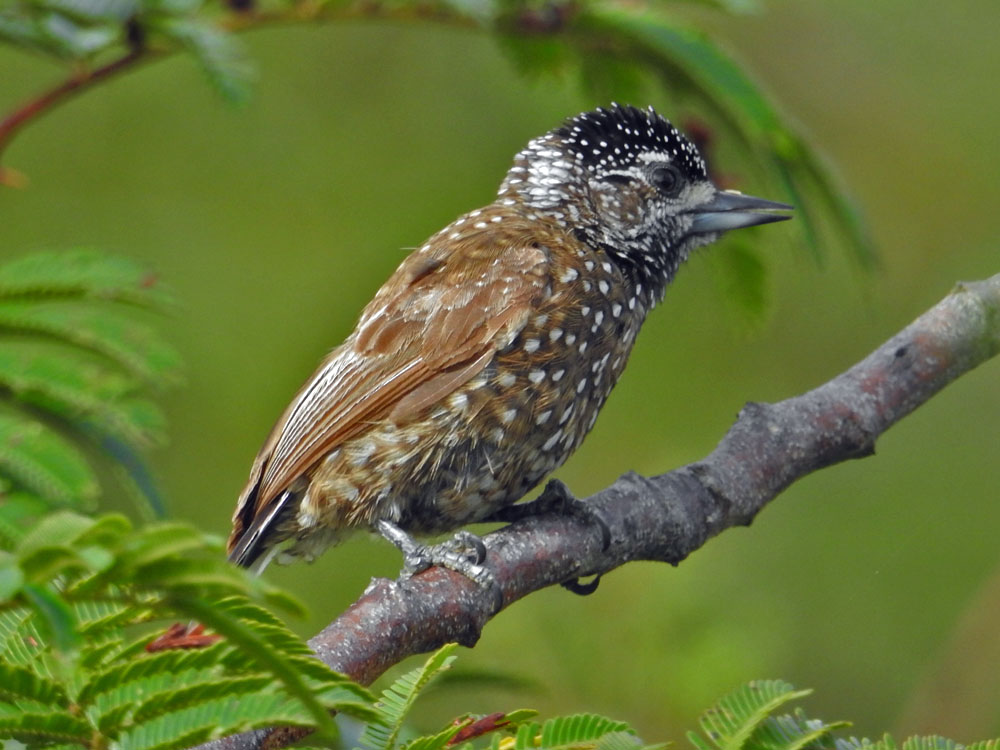
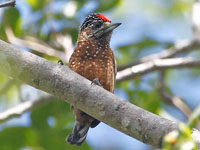
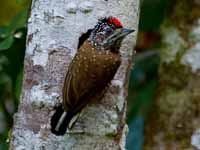
Piculet,_Tawny Picumnus fulvescens
Description: The tawny piculet has brown upperparts, pale tawny underparts with faint streaks over the breast, and a black crown which is spotted with white. The male has red on his fore-crown. It is 10 cm long. The tawny piculet has more deeply saturated underparts than the similar ochraceous piculet. Also, tawny's range is more south and east than Ochraceous's range.
Range: Eastern Brazil.
Habitat: Subtropical or tropical dry forests.
Diet: Probably insects.
Conservation status: Least Concern.
Image by: 1, 2) Murilo_Nascimento 3) Nick_AthanasRange: Eastern Brazil.
Habitat: Subtropical or tropical dry forests.
Diet: Probably insects.
Conservation status: Least Concern.

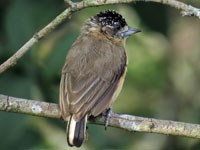

Piculet,_Varzea Picumnus varzeae
Description: The varzea piculet has dark brown upperparts and face. The male has a mainly black crown with red fore-crown while the female has a black crown. The black part of the crown has small white spots. The underparts are brown with white barring and stripes. The varzea piculet is 8 to 9 cm long.
Range: Brazil's Amazon basin.
Habitat: Along the Amazon River in the várzea forest, a freshwater swamp forest.
Diet: Probably small insects.
Conservation status: It is listed as Endangered because its population is declining due to deforestation.
Image by: 1, 2) Cornell_Univ's_Neotropical_Birds_Online - Anselmo_d’Affonseca Range: Brazil's Amazon basin.
Habitat: Along the Amazon River in the várzea forest, a freshwater swamp forest.
Diet: Probably small insects.
Conservation status: It is listed as Endangered because its population is declining due to deforestation.
1) Female 2) Male
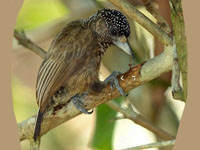
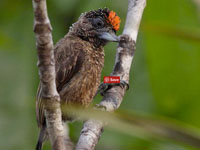
Piculet,_White-barred Picumnus cirratus
Description: The white-barred piculet has brown upperparts, a black crown (male has red fore-crown), and white underparts with black bars. The white-barred piculet is 9 to 10 cm long.
Range: Argentina, Bolivia, southeast Brazil, Paraguay. A northerly population is in Guyana, guianan, and northern Brazil.
Habitat: Woodlands and scrub.
Diet: Ants, beetles, larvae, other small invertebrates.
Conservation status: Least Concern.
Image by: 1) Cláudio Timm - Argentina, 2) Dario_Sanches 3) Carlos_Henrique 4) Hudson Range: Argentina, Bolivia, southeast Brazil, Paraguay. A northerly population is in Guyana, guianan, and northern Brazil.
Habitat: Woodlands and scrub.
Diet: Ants, beetles, larvae, other small invertebrates.
Conservation status: Least Concern.
1, 2) Female 3, 4) Male
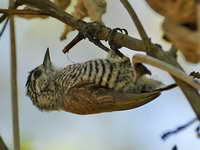
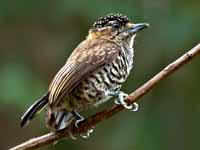

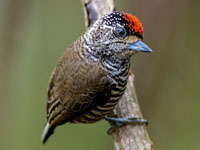
Piculet, White-bellied Picumnus spilogaster
Description: The white-bellied piculet has greenish-brown upperparts and a black cap with mainly white dots (male has red dots at forehead); The underparts are off-white with black barring on the upper-breast and spots on the lower-breast and flanks. The belly is relatively spot free. The white-bellied piculet is about 9 cm long.
Range: Brazil, French Guiana, Guyana, Suriname, and Venezuela.
Habitat: Forests and also heavily degraded forests.
Diet: Probably insects and larvae.
Conservation status: It is listed as Vulnerable because it has a small range and little is known about its population.
Image by: 1) Dave Curtis - Guyana 2) Josh_VandermeulenRange: Brazil, French Guiana, Guyana, Suriname, and Venezuela.
Habitat: Forests and also heavily degraded forests.
Diet: Probably insects and larvae.
Conservation status: It is listed as Vulnerable because it has a small range and little is known about its population.
1) Female 2) Male
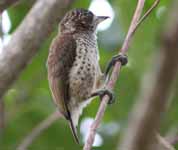
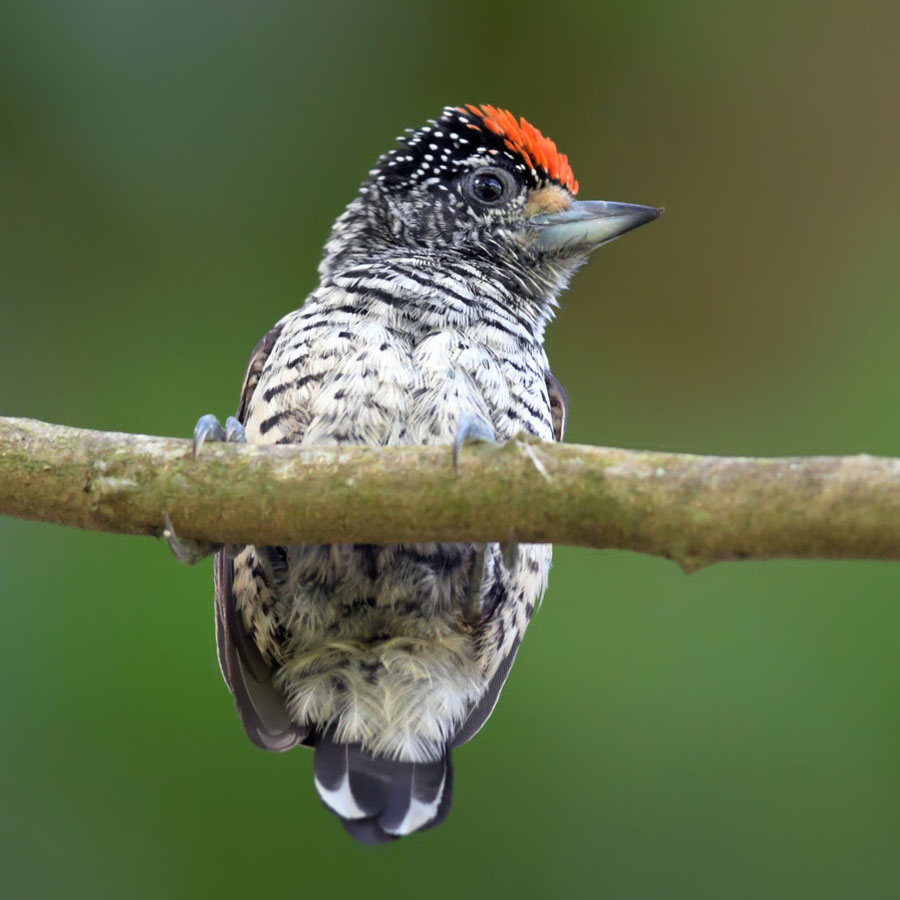
Piculet, White-wedged Picumnus albosquamatus
Description: The white-wedged piculet has olive-brown upperparts with some pale speckling on the mantle. The crown is black (male red fore-crown) with white speckles. The underparts are mostly white with black scaling that can have a wedge-like appearance, The flanks and lower-belly have less scaling. It has a blackish bill with the lower manible more grey, especially at the base. The white-wedged piculet is 10 to 11 cm long.
Range: Southern Bolivia, Brazil, northern Paraguay.
Habitat: Forests, woodlands, and savanna.
Diet: Insects and other small invertebrates which it garners from trees.
Conservation status: Least Concern.
Image by: 1) Claudio_D_Timm 2) Nick_Athanas - Brazil 3) Wagner Lemes Range: Southern Bolivia, Brazil, northern Paraguay.
Habitat: Forests, woodlands, and savanna.
Diet: Insects and other small invertebrates which it garners from trees.
Conservation status: Least Concern.
1, 2) Female 3) Male
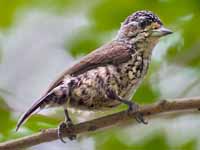
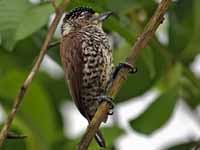

Genus Sasia
These two piculets are found in Asia. Their tail is almost nonexistant. Their nests are excavated in trees or bamboo, less than a meter from the ground.
Piculet,_Rufous Sasia abnormis
Description: The rufous piculet has green upperparts. The underparts are rufous, orange, or cinnamon with the flanks being paler. It has a brownish upper-wing and buff under-wing. The blackish tail is very small and almost non-existent. The male has a yellow patch on his forehead while the female has a bronze patch. The feet only have 3 toes, compared to four for almost all other woodpeckers.The rufous piculet is 8 to 10 cm and about 8 grams.
Range: Brunei, Indonesia, Malaysia, Myanmar, Thailand.
Habitat: Dense humid secondary forests with tangled undergrowth, vines, creepers; often near streams.
Diet: Mainly ants, termite, beetles, and their larvae. Also other small invertebrates. Forages by pecking and gleaning.
Conservation status: Least Concern.
Image by: 1) Francesco_Veronesi - Thailand 2) Michael_Gillam - Thailand 3) LonelyShrimpRange: Brunei, Indonesia, Malaysia, Myanmar, Thailand.
Habitat: Dense humid secondary forests with tangled undergrowth, vines, creepers; often near streams.
Diet: Mainly ants, termite, beetles, and their larvae. Also other small invertebrates. Forages by pecking and gleaning.
Conservation status: Least Concern.
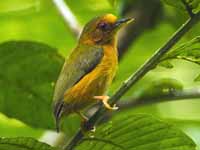
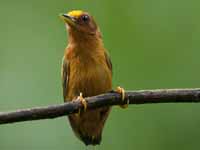
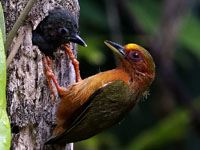
Piculet,_White-browed Sasia ochracea
Description: The white-browed piculet has olive-green upperparts which may be tinged with chestnut. It has a green crown, white supercilium, and pinkish orbital skin. The male has a yellow patch on the forehead. It has cinnamon or rufous underparts and the flanks are sometimes yellowish. The stubby tail is blackish. It has a grey bill and yellow legs. The feet only have 3 toes, compared to four for almost all other woodpeckers. The white-browed piculet is up to 10 cm long.
Range: Indian subcontinent, southeast Asia.
Habitat: Dense forest with plenty of vines and bamboo. Also scrub and swampy woodlands.
Diet: Mainly ants, termite, beetles, and their larvae.
Conservation status: Least Concern.
Image by: 1, 2) Vijay_Ismavel - India 3) Tareqctg 4) Dibyendu_Ash - IndiaRange: Indian subcontinent, southeast Asia.
Habitat: Dense forest with plenty of vines and bamboo. Also scrub and swampy woodlands.
Diet: Mainly ants, termite, beetles, and their larvae.
Conservation status: Least Concern.
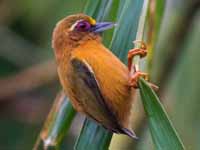

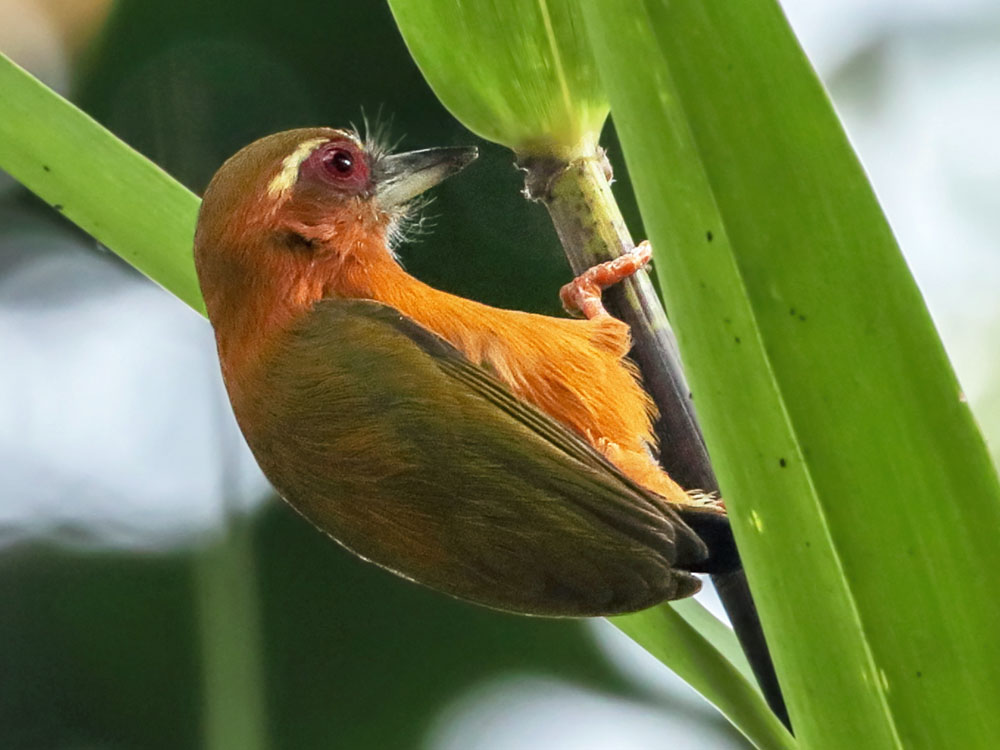

Genus Verreauxia - 1 species
Piculet,_African Verreauxia africana also Sasia africana Found: Africa
Description: The male African piculet has upperparts mainly dark green and tinged with yellow. It has a greenish crown, reddish forehead, and brownish-black wings. The throat and breast are grey while the belly is paler, It has a black bill and reddish legs. The female does not have a red forehead. The African piculet is 9 to 10 cm long.
Range: West central Africa.
Habitat: Mainly secondary forests.
Diet: Beetle larvae, other insects, but does not seem interested in ants which is unusual for a piculet.
Conservation status: Least Concern.
Image by: 1) Adriana_RubinsteinRange: West central Africa.
Habitat: Mainly secondary forests.
Diet: Beetle larvae, other insects, but does not seem interested in ants which is unusual for a piculet.
Conservation status: Least Concern.
